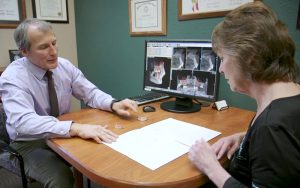Local Anesthesia: Anesthetics in Dentistry in Loveland, CO
Feel Comfortable During Your Dental Visit
Local anesthetics are essential tools in modern dentistry, providing pain relief during various dental procedures. Dentists use these medications to ensure patients have a comfortable and pain-free experience while receiving dental care.
It’s crucial to manage allergic reactions to local anesthetics effectively to ensure patient safety and comfort during dental procedures. This includes identifying potential allergies to both amide and ester anesthetics and being prepared to address reactions ranging from aphthous ulceration to anaphylaxis.
At the Center for Advanced Dentistry, our Loveland, CO, dentist, Dr. Andrew Howard, will ensure that every patient feels comfortable during their visit. To schedule an appointment, contact us today by calling (970) 669-3918.
What Are Local Anesthetics?
 Local anesthetics are designed to block sensation in a specific area of the body. In dentistry, they’re used to create numbness in the oral cavity, including the mouth, gums, and teeth. This numbing effect is crucial for ensuring that dental procedures are virtually painless.
Local anesthetics are designed to block sensation in a specific area of the body. In dentistry, they’re used to create numbness in the oral cavity, including the mouth, gums, and teeth. This numbing effect is crucial for ensuring that dental procedures are virtually painless.
Local anesthetics function by interfering with the transmission of pain signals from nerve endings to the brain. They achieve this by blocking sodium channels in nerves, preventing the nerves from sending pain signals.
With local anesthetics, dentists can perform a wide array of procedures, such as fillings, extractions, root canals, and gum surgeries, with minimal or no pain for the patient. In addition to blocking pain signals, monitoring vital signs like blood pressure is crucial in procedures involving sedation or general anesthesia.
Types of Local Anesthetics in Dentistry
There are several types of local anesthetics used in dentistry. Our dentist will always inform you of what is being used before your dental treatment.
Common local anesthetics include:
- Lidocaine: One of the most commonly utilized local anesthetics in dentistry. It’s renowned for its rapid onset of action and effectiveness in providing relief from pain.
- Articaine: It’s gaining popularity in dental practice due to its high potency and ability to perform well in inflamed tissues, making it an excellent choice for certain dental procedures.
- Mepivacaine: This is preferred when a longer-lasting numbing effect is required. It’s particularly suitable for more extended and complex dental procedures.
- Prilocaine: This is often chosen for patients who may be sensitive to other local anesthetics, as it carries a lower risk of causing allergic reactions.
- Bupivacaine: Used in situations where prolonged anesthesia is necessary. It offers an extended duration of action, making it suitable for specific dental treatments.
How a Local Anesthetic Is Administered
Injections
The most common method of administering a local anesthetic is through injections. These injections are usually targeted at the gum tissue or near the nerves of the affected area. Specifically, targeting the inferior alveolar nerve is crucial for effective anesthesia in procedures involving the lower jaw and teeth, ensuring the patient’s comfort and pain management during dental treatments.
Topical Anesthetics
Before administering injections, dentists often apply topical anesthetics to the surface of oral tissues. These topicals numb the area, reducing the pain associated with the insertion of the injection needle.
The Wand (Computer-Assisted Anesthesia)
The Wand is a computer-assisted system designed to precisely control the flow rate and pressure of the anesthetic solution during injections. This advanced technology enhances the accuracy and comfort of the injection process for patients.
Dental Procedures Where Local Anesthetics May Be Used
 Dental anesthesia and dental anesthesia are numbing methods used in various dental treatments to provide pain relief and ensure patient comfort during the procedures. Common treatments include:
Dental anesthesia and dental anesthesia are numbing methods used in various dental treatments to provide pain relief and ensure patient comfort during the procedures. Common treatments include:
- Dental Fillings: A local anesthetic is frequently used when dentists need to remove decayed tooth material and fill cavities.
- Tooth Extractions: When a tooth needs to be removed due to severe damage, infection, or orthodontic reasons, a local anesthetic is administered to numb the area around the tooth, making the extraction painless.
- Root Canal Therapy: Root canals involve the removal of infected or damaged pulp inside a tooth. Anesthetics are essential to numb the tooth and surrounding tissues to alleviate pain during this dental procedure.
- Temporomandibular Joint (TMJ) Injections: In cases of TMJ disorders or jaw pain, a local anesthetic may be used for therapeutic injections to alleviate pain and discomfort.
- Periodontal Treatment: Periodontal treatments such as scaling and root planing, which aim to treat gum disease, may involve local anesthetics to make the procedure more comfortable.
For more extensive dental procedures where local anesthetics might not be sufficient, general anesthesia is an option that can provide complete unconsciousness and pain relief, ensuring the patient’s comfort and safety throughout the treatment.
Frequently Asked Questions
When administered correctly by a trained dental professional, local anesthetics are generally safe. Most risks arise from factors such as overdose, allergic reactions, or improper administration.
For certain minor dental procedures, alternatives such as nitrous oxide (laughing gas) or conscious sedation may be considered. However, these options depend on the procedure’s complexity and the patient’s preferences, and they should be discussed with the dentist.
Learn More About Dental Sedative Options
If you have any concerns or questions about local anesthetics, don’t hesitate to reach out to our dentist. We’re equipped to provide you with personalized information and address any specific concerns you may have. Your oral health and comfort are our top priorities.
Contact our Loveland, CO, dental office today. We also welcome patients from Evans, Campion, and Garden City, CO.
